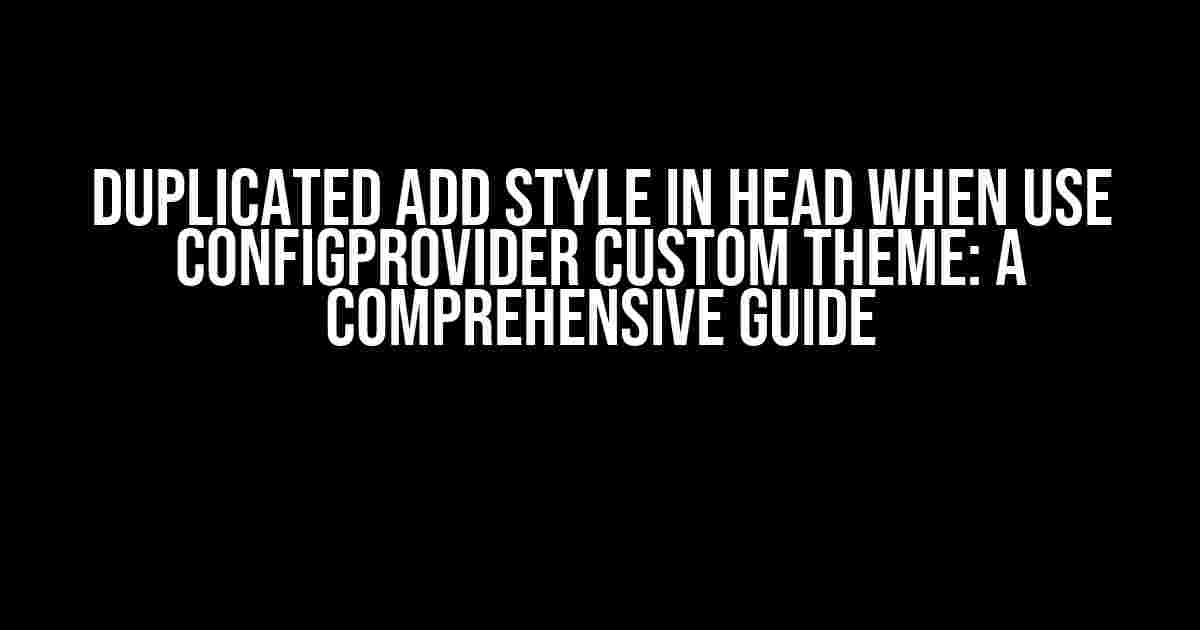Are you tired of dealing with duplicated styles in your Ant Design project when using a custom theme with ConfigProvider? You’re not alone! This issue can be frustrating, especially when you’ve invested so much time and effort into crafting the perfect design. Fear not, dear developer, for we’ve got you covered. In this article, we’ll dive into the world of custom themes, ConfigProvider, and duplicated styles, and provide you with clear and direct instructions on how to overcome this hurdle.
What is ConfigProvider?
Before we dive into the issue at hand, let’s take a step back and understand what ConfigProvider is. ConfigProvider is a powerful utility in Ant Design that allows you to customize and override the default theme settings. With ConfigProvider, you can create a custom theme that aligns with your brand’s identity, making it a vital tool for enterprises and organizations with unique design requirements.
Why do we need ConfigProvider?
So, why do we need ConfigProvider? The answer lies in the flexibility and customization it offers. By using ConfigProvider, you can:
- Override default theme settings, such as colors, typography, and spacing
- Define custom components and layouts
- Create a consistent design language across your application
- Integrate with third-party libraries and frameworks
Now that we’ve covered the basics of ConfigProvider, let’s move on to the issue of duplicated styles in the head section when using a custom theme.
The Problem: Duplicated Styles in Head
When using a custom theme with ConfigProvider, you might have noticed that your styles are being duplicated in the head section of your HTML document. This can lead to:
- Increased page load times
- Conflicting styles and layout issues
- Poor performance and responsiveness
But fear not, we’ve identified the root cause of this issue and are ready to provide a solution.
Why do duplicated styles occur?
The reason behind duplicated styles is due to the way Ant Design loads its styles. When you use ConfigProvider to customize your theme, Ant Design will generate a new stylesheet based on your custom settings. However, this new stylesheet is not automatically merged with the existing styles. Instead, it’s added as a separate stylesheet in the head section, resulting in duplicated styles.
The Solution: Merging Styles with ConfigProvider
Now that we’ve identified the problem, let’s move on to the solution. To merge styles with ConfigProvider, you’ll need to use the `getCssText` method provided by Ant Design. This method returns the generated CSS text based on your custom theme settings.
import { ConfigProvider } from 'antd';
import customTheme from './customTheme';
const App = () => {
const theme = getCssText(customTheme);
return (
<ConfigProvider theme={{ ...theme }}>
<AppContent />
</ConfigProvider>
);
};
In the example above, we’re importing the `ConfigProvider` component and our custom theme settings from a separate file. We then use the `getCssText` method to generate the CSS text based on our custom theme. Finally, we pass the generated theme object to the `ConfigProvider` component.
Understanding getCssText()
The `getCssText` method is a powerful utility provided by Ant Design. It takes your custom theme settings and generates a CSS text that can be used to override the default theme settings. Here’s a breakdown of how it works:
`getCssText` takes an object with the following properties:
| Property | Description |
|---|---|
| theme | The custom theme settings object |
| vars | An object containing variable definitions for the theme |
The `getCssText` method will then generate a CSS text based on the provided theme settings and variables. This generated CSS text can be used to override the default theme settings, ensuring that your custom theme is applied correctly.
Best Practices for Custom Themes with ConfigProvider
To ensure that your custom theme works seamlessly with ConfigProvider, follow these best practices:
- Keep your custom theme settings organized: Use a separate file to store your custom theme settings, and keep it organized using a clear and concise naming convention.
- Use a consistent naming convention for variables: Use a consistent naming convention for your variables, such as `prefix-variable-name` or `variableName`.
- Avoid duplicated variable definitions: Make sure to avoid duplicated variable definitions in your custom theme settings.
- Test your custom theme thoroughly: Test your custom theme thoroughly to ensure that it works as expected, and make adjustments as needed.
By following these best practices, you’ll be able to create a custom theme that aligns with your brand’s identity and works seamlessly with ConfigProvider.
Conclusion
In this article, we’ve covered the issue of duplicated styles in the head section when using a custom theme with ConfigProvider. We’ve identified the root cause of the issue and provided a solution using the `getCssText` method. Additionally, we’ve provided best practices for creating and maintaining custom themes with ConfigProvider.
By following the instructions and guidelines outlined in this article, you’ll be able to overcome the hurdle of duplicated styles and create a stunning, custom theme that elevates your Ant Design project to the next level.
So, go ahead and unleash your creativity! Create a custom theme that reflects your brand’s identity, and watch your Ant Design project come to life.
Frequently Asked Question
Get the lowdown on configuring your custom theme with ConfigProvider – we’ve got the answers to your burning questions!
Why do I see duplicated add styles in the head when using ConfigProvider with a custom theme?
This is a common gotcha! When you use ConfigProvider with a custom theme, it’s possible that your theme is being loaded twice, resulting in duplicated styles in the head. Check your theme configuration to ensure that you’re not accidentally importing the theme twice.
How do I prevent duplicated add styles in the head when using ConfigProvider with a custom theme?
Easy peasy! To prevent duplicated styles, make sure to remove any unnecessary theme imports from your config file. Also, verify that your theme is being loaded only once in your application. If you’re still experiencing issues, try setting the `appendStyles` option to `false` in your ConfigProvider settings.
What happens if I don’t set the `appendStyles` option to `false`?
If you don’t set the `appendStyles` option to `false`, your theme styles will be appended to the existing styles in the head, resulting in duplicated styles. This can lead to styling issues and inconsistent behavior in your application.
Can I use ConfigProvider with a custom theme in a server-side rendered (SSR) application?
Yes, you can! ConfigProvider works seamlessly with custom themes in SSR applications. Just make sure to follow the same best practices for configuring your theme and preventing duplicated styles in the head.
Where can I find more information on using ConfigProvider with a custom theme?
For more information on using ConfigProvider with a custom theme, check out the official documentation and tutorials on the ConfigProvider website. You can also search for online forums and tutorials that provide step-by-step guides and examples.


